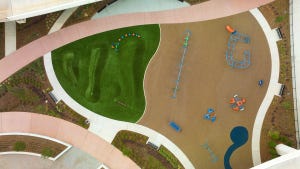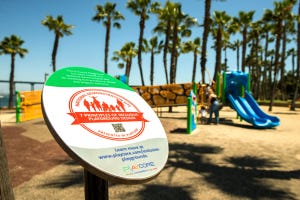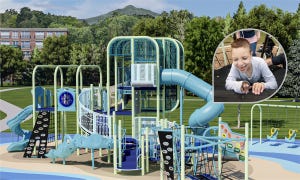Playground safety is an issue of paramount importance. The National Recreation and Parks Association estimates more then 2/3 of playground injuries occur because of poor or neglected maintenance. Voice of Play, the communication and outreach section of IPEMA, asks these top 10 questions everyone should ask about playground safety.
1. Is the playground surface safe?
Unsafe surfaces such as concrete—and sometimes even grass—have the risk of severely injuring or killing. Falling is the number one cause of injuries on the playground, and therefore it is important to restrict children from playing on equipment placed on hard surfaces like asphalt, concrete and packed earth or grass. Acceptable playground surfacing should be certified wood fiber, shredded rubber or poured-in-place surfacing.
2. Is there enough room underneath and around playground equipment?
The general rule is to allow a minimum use zone of six feet around playground equipment. Refer to the ASTM 1487 Standard or the Consumer Product Safety Commission guidelines for specific use zone requirements.
3. Is there enough space between the pieces of playground equipment?
The general rule is to allow a minimum use zone of six feet around playground equipment. Refer to the ASTM F1487 Standard or the Consumer Product Safety Commission guidelines for specific use zone requirements.
4. Is the playground appropriate for the child?
Each playground should be designed appropriately to meet the needs of children that vary in age and ability. Utilize playground equipment designed children ageds 2 to 5 or 5 to 12.
5. Does the equipment put the child at risk from protruding objects?
Jutting pieces of hardware should not be on the equipment. Protruding objects could severely cut or injure children.
6. Does the playground equipment present a strangulation risk?
Look for anything that has the potential of snagging clothing, jewelry or strings.
7. Are there any moving parts that could pinch a child?
There should no accessible points where kids could possibly get pinched or crushed or could catch their clothing on.
8. Is there anything that might cause a child to trip?
Surfaces should be smooth and free of all tripping hazards. Ensure the ground is level by checking for tree stumps, roots or rocks.
9. Is the playground well maintained?
Playground equipment and hardware should be well kept. Rust and other deterioration are signs to reevaluate maintenance procedures. Regular inspection is important to keep the playground in good condition.
10. Has the playground been renovated since 1993?
Out-of-date equipment can be extremely dangerous. From the 1960s through the 1980s, playgrounds were commonly equipped with heavy metal swings. However, this piece of equipment can potentially injure children who walk in front of them. Frequent renovation is essential in order to secure playground safety.
Keep Your Playground Up to Date
If you are concerned about the condition of your playground, contact the local GameTime playground expert in your neighborhood. You can also request a free copy of our playground maintenance guide.
- Trails (27)
- Schools (180)
- Press Releases (102)
- Playground Funding (3)
- Play Science & Research (62)
- Parks & Recreation (339)
- Outdoor Fitness (137)
- National Demonstration Site (32)
- Landscape Architects (72)
- Inclusive Play (101)
- Daycare and Early Learning (62)
- Custom Play (36)
- College Campus (27)
- Churches (50)
- Challenge Course (30)
- Featured Projects (72)
- Site and Shade (6)





